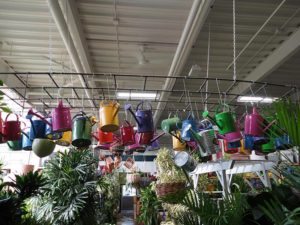Immediate Sale, Lifetime Customer
You’ve heard or read these topics discussed before … What behaviors drive consumer purchases? What sets you apart from your competition, be it the big box down the street, another locally owned garden center (LOGC) in your community or non-hort venues or activities that compete for the consumers’ time and money? How can you build consumption, both from your existing customers and from those where our products aren’t even on their radar?…
We’d like to believe a national marketing campaign is the simple answer, letting someone else build demand for our products. And while that might help create awareness, any campaign would only be effective if it was leveraged at the individual store level, building sales and consumption one customer at a time.
We’d like to believe the products in the LOGC are superior to those carried by the big boxes, but the reality in many cases is both channels are purchasing from the same producers. And while we used to be able to say the care, maintenance, presentation and display of the product in the LOGC are superior, the advent and expansion of vendor service/pay by scan in the boxes has leveled this playing field to a large degree.
I am a firm believer, as many others are, that the keys to success lie in the areas of 1. establishing and communicating your value proposition, 2. creating relevancy for both your products and your store for the consumers in your individual market and 3. being authentic and real (i.e. telling your story). Great concepts, but how does this really translate in your business and in your customer’s mind?
Beginning the Process
I just went through a consumer journey in a highly competitive industry totally unrelated to ours. As I went through this process, I kept seeing parallels to what we do and don’t do as retailers in our industry. Let me set the stage for you.
My wife, Rosemary, drives a 2007 Honda CR-V that we both love; this is the vehicle that we use when we go out together. I was driving a 1998 (yes, I know that’s 18 years old) Mazda Protege. The Mazda was nicknamed the Romeomobile because my black lab Romeo and I traveled in that car. I used it for errands and left it at the airport for days on end. It was reliable, fuel efficient, ran like a top, required minimal work beyond regular maintenance and was in great shape (but, needless to say, my wife refused to ride in my almost antique car.)
While my wife called me too cheap to buy a new car, I viewed myself as practical, driving a car that was great transportation, refused to die and that I had developed a sentimental attachment to (my wife suggested I see a psychologist for that last point!). However, it was about to require some major work and I finally decided it was time to retire the Romeomobile (which I donated to a local charity).
Now began my journey to find a replacement. Within a 10-minute drive of my home, there are Ford, Mazda, Honda, Nissan and Toyota dealers (as well as Maserati, Jaguar, Bentley, Rolls Royce, Porsche, Audi and Mercedes dealers, but, hey, like you, I work hard for my money!). I was unsure whether I wanted to buy a mid-sized sedan or an SUV, and since I had been out of the car market for seven years, I made the rounds of the dealers to help me decide.
Shopping Around
The first thing I learned was that most dealers utilized “fair value” pricing formulas; they allegedly shopped their competitors and applied all the available discounts so there was little price haggling (I did find out, however, there was still wiggle room if you negotiated.) The second thing I learned was there was so much pricing information on the Internet (i.e. MRSP, invoice costs, manufacturer rebates, brand comparisons, etc.) that there simply were no secrets (one dealer mentioned that the average new car buyer has done 16 hours of Internet research before they set foot on a dealer’s floor!).
Please note I am not judging the quality of any of the brands I’m discussing below, but rather the dealers I interacted with.
Let’s start with the Ford dealer. I had heard good things about improvements in Ford quality and innovation. I was met by a young, energetic salesperson on a very cramped sales floor who asked me what I was looking for (but never pre-qualified my needs and wants) and immediately offered to take me for a test ride. When I suggested I wanted to know a little bit about the sedan and SUV he wanted to direct me to, we went over to the display vehicles and he attempted to demonstrate some of their high-tech features. I say “attempted” because both of the cars had dead batteries and nothing tech, door locks, trunk, etc. worked. As a consumer, Ford was immediately crossed off the list of candidates due to lack of professionalism and the thought that if they couldn’t keep their display cars running, their service operation was probably equally challenged.
On to Nissan, I walked onto the sales floor and gave myself a self-guided tour of the cars on display; there was a group of five or six salesmen standing around laughing and seemingly having a great time, but, though a few turned around and saw me walking around, none approached me. I seem to remember the same thing happened seven years ago when I was looking for an SUV. Apparently there’s a culture here of not being customer-centric. Scratch Nissan off the list … permanently!
As for Toyota … nice cars, higher priced, good service reputation and a pushy, high-pressure salesperson. When I told him Toyota was on my list of candidates, but I was still considering others, I got daily phone calls, and he started throwing around small ($250) discounts on each call to entice me to sign on (so much for “fair value” pricing). Toyota was originally high on my list, but a pesty salesman blew their chance.
Finally I went to the Honda dealer, where I had previously purchased my wife’s CR-V and I’ve always had an excellent experience; at the end of the day, I guess in my mind, it was their sale to lose. My salesman, new to the industry, sat me down and asked all the right questions: intended use, must-have features, etc.; only then did he recommend vehicles to consider. If he didn’t know the answer to a technical question, he immediately found an in-house expert to provide it. He offered suggestions on why a sedan versus another SUV. Only after we had done all of the prep work did we test drive the car, and I ultimately purchased, a 2015 Accord EX-L.
Going Beyond the Sale
Thinking back on this whole journey the most important takeaway for me was that all the other dealers were trying to sell me a car, a transactional mentality; none of them seemed to consider I probably will be trading my wife’s CR-V in for another SUV within 12 to 18 months. Honda, on the other hand, embraced the concept and mentality of the lifetime value of a customer. They’re leveraging the potential I’ll purchase vehicles from them in the future and recommend them to family and friends by treating me fairly as an individual, making the investment in providing consistently excellent post-purchase service and an overall great experience.
Good quality is your ticket to admission to play the game; it’s everything else that enriches the customer experience and develops the relationships that lead to your long-term success.
My question to you is, are you in the transactional business, selling one plant at a time, or are you in the business of creating a lifetime value relationship with your customers?…


















 Videos
Videos





